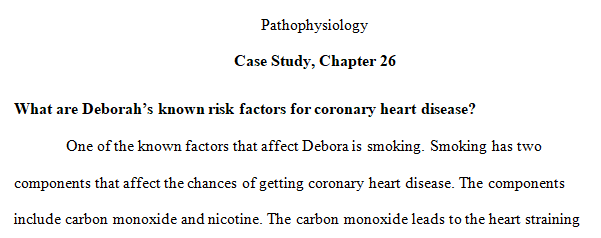
What are the benefits of administering fibrinolytic therapy, nitroglycerin, and oxygen in the early management of STEMI?
Pathophysiology
Complete these case studies–Provide at least tworeferences. Avoid plagiarism. No more than four pages (add the references on a fifth page).Due on Tuesday, September 29th, 2020.
This link below is the e-book of pathophysiology.
https://drive.google.com/file/d/1TYSw5uTjyTm2uj4xx28TbvS2BNTYZ0_j/view
Case Study, Chapter 26, Disorders of Blood Flow and Blood Pressure Regulation
Deborah is 56 years old, smokes half a pack of cigarettes a day, and is overweight. Her friend wants her to come to a local women’s fitness class she attends to once a week. She knows Deborah’s dad had died an acute myocardial infarction when he was 56, and she fears, seeing Deborah’s lifestyle, the same fate awaits her friend. What she did not know was that Deborah had also been to her doctor for her annual physical where she was told her LDLs were 180 mg/dL, HDLs were 36 mg/dL, and cholesterol was 239 mg/dL (Learning Objectives 3 and 4).
- What are Deborah’s known risk factors for coronary heart disease?
- Deborah’s doctor referred her to a dietician for strict dietary therapy, hoping the intervention would raise her HDL and lower her LDL and cholesterol levels. Why is diet modification necessary to control and moderate the lipids indicated?
- Deborah’s doctor also gave her pamphlets describing strategies to stop smoking and a list of exercise ideas she might want to try. How is smoking thought to contribute to atherosclerotic plaque formation? Why would exercise have a positive effect on Deborah’s lipid profile?
- Atherosclerosis is thought to be an inflammatory disorder. What is the role of macrophages in the formation of atherosclerotic plaques? What is the significance of elevated serum hs-CRP levels in at-risk individuals?
Case Study, Chapter 27, Disorders of Cardiac Function, and Heart Failure and Circulatory Shock
Martha had just finished dinner with her husband, and they had just sat down to watch television. She is 72 years old and has had a history of angina. Shortly after they sat down, Martha said she had indigestion and went to take some antacid tablets. An hour later, she began to feel warm, restless, and anxious. Her husband noticed she was looking pale and said he would take her to a nearby walk-in clinic. By the time they arrived, Martha said her left arm and shoulder were sore. Suspecting Martha was having a heart attack, her husband turned the car around and rushed her to the hospital. Three hours after the onset of her symptoms, Martha was receiving oxygen, fibrinolytic therapy, and nitroglycerin in the emergency ward. Afterward, she was moved to the cardiac unit for STEMI (Learning Objectives 5 and 6).
- An ECG of Martha’s heart demonstrated an elevated ST segment. What are the physiologic effects of myocardial ischemia that produce this finding? What variables affect the ECG tracing of a patient with ACS?
- What are the benefits of administering fibrinolytic therapy, nitroglycerin, and oxygen in the early management of STEMI?
- What is the inflammatory response in the postinfarction recovery period? Why will Martha’s heart function be compromised after her STEMI?
Please, answer the questions without adding the scenario on the pages that you will send to me, just the questions and the answers. No more than four pages (add the references on a fifth page).
For example,
- Question
Answer
- Question
Answer
Subject: Nursing
Answer preview………………….. apa 1362 words
apa 1362 words